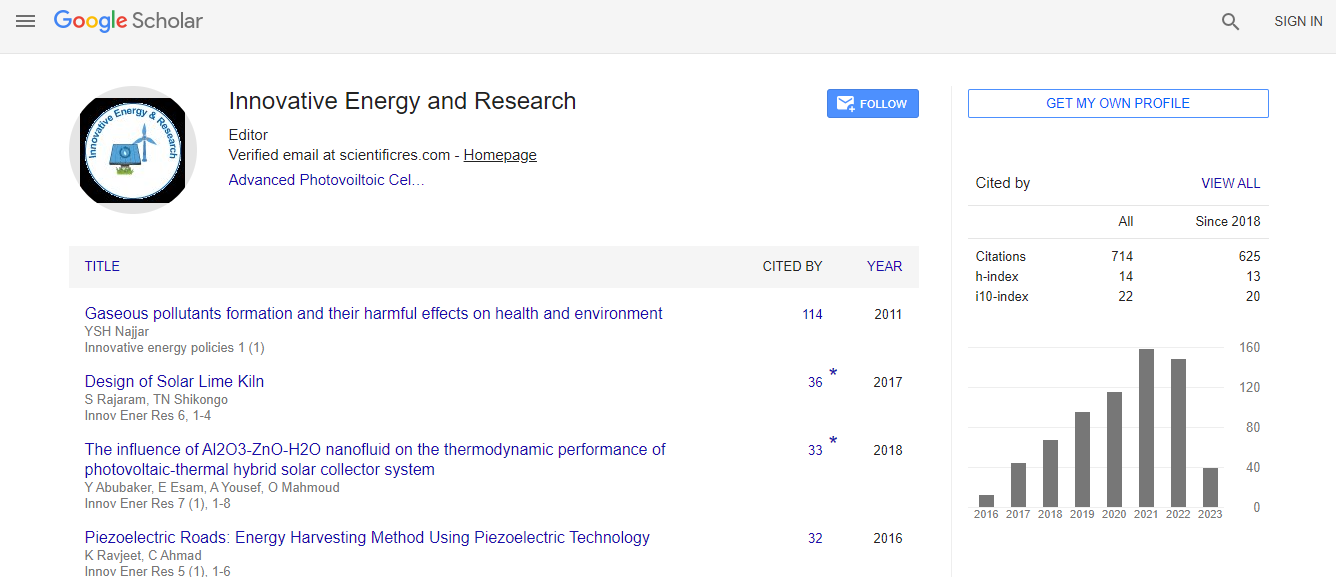Our Group organises 3000+ Global Conferenceseries Events every year across USA, Europe & Asia with support from 1000 more scientific Societies and Publishes 700+ Open Access Journals which contains over 50000 eminent personalities, reputed scientists as editorial board members.
Open Access Journals gaining more Readers and Citations
700 Journals and 15,000,000 Readers Each Journal is getting 25,000+ Readers
Google Scholar citation report
Citations : 712
Innovative Energy & Research received 712 citations as per Google Scholar report
Innovative Energy & Research peer review process verified at publons
Indexed In
- Google Scholar
- Open J Gate
- Genamics JournalSeek
- RefSeek
- Hamdard University
- EBSCO A-Z
- Publons
- Euro Pub
- ICMJE
Useful Links
Recommended Journals
Related Subjects
Share This Page
Biomass-derived activated carbon scaffolds for electrochemical energy storage
20th International Conference on Advanced Energy Materials and Research
Xiaodong Li
University of Virginia, USA
Keynote: Innov Ener Res
Abstract
With increasing energy and environment concerns, how to efficiently convert and store energy has become a critical topic. Electrochemical energy storage devices, such as supercapacitors and batteries, have been proven to be the most effective energy conversion and storage technologies for practical application. Supercapacitors and lithium-based batteries are particularly promising because of their excellent power density and energy density. However, further development of these energy storage devices is hindered by their poor electrode performance. The carbon materials in supercapacitors and batteries, such as graphite, activated carbons and various nanostructured carbon materials (ordered porous carbon, CNT, graphene etc.), are often derived from nonrenewable resources under relatively harsh environments. Naturally abundant biomass with hierarchically porous architecture is a green, alternative carbon source with many desired properties for supercapacitors and lithium-based batteries. Recently, we converted cotton, banana peel, and recycled paper into highly porous, conductive activated carbon scaffolds for advanced energy storage applications via a low-cost and high throughput manufacturing process. The activated carbon scaffolds were further coated with active materials such as NiCo2O4, NiO, Co-Al layered double hydroxides (Co-Al LDHs), Ni2S, sulfur nanoparticles, and graphene to enhance their electrochemical properties. The biomass-derived activated carbon materials are effective in improving supercapacitor’s energy density and in blocking the dissolution of reaction intermediates in lithium sulfur batteries. Especially, the biomass-derived carbons provide scaffolds for hosting sulfur in lithium sulfur batteries to manipulate the “shuttle effects” of polysulfides and improve the utilization of sulfur. In particular, the activated carbon textiles (derived from cotton textiles) are flexible and conductive, and an ideal substrate for constructing flexible supercapacitors, batteries, and self-powered flexible solar cell/supercapacitor (or battery) systems. Using biomasses is definitely the right track towards making renewable carbon materials for future energy storage devices. Recent Publications 1. Gao Z, Bumgardner C, Song N, Zhang Y, Li J, Li X (2016) Cotton-textile-enabled flexible self-sustaining power packs via roll-to-roll fabrication. Nature communications 7: 11586. 2. Gao Z, Song N, Zhang Y, Li X (2015) Cotton Textile enabled, flexible lithium-ion batteries with enhanced capacity and extended Lifespan. Nano letters 15: 8194–8203. 3. Bao L, Li X (2012) Towards textile energy-storage from cotton T-shirts. Advanced materials 24: 3246-3252. 4. Zhang Y. Gao Z, Li X (2017) Capillarity composited recycled paper/graphene scaffold for lithium-sulfur batteries with enhanced capacity and extended lifespan. Small 13: 1701927. 5. Zhang Y, Gao Z, Song N, Li X (2016) High-performance supercapacitors and batteries derived from activated banana-peel with porous structures. Electrochimica acta 222: 1257–1266.Biography
Xiaodong Li is a Rolls-Royce Commonwealth Professor at the University of Virginia with expertise and interests including nanomaterial-enabled energy systems, biological and bio-inspired materials and devices, additive manufacturing, smart manufacturing, biomechanics, micro/nanomechanics, surface engineering, and tribology. His stature in the field of his expertise includes over 230 peerreviewed journal articles in prestigious journals such as Science, Nature Communications, Advanced Materials, and Advanced Energy Materials; over 12,000 citations with H-index of 54; TMS MPMD Distinguished Scientist/Engineer Award (2015), Professional Engineering Publisher's PE Prize (2008); over 80 invited plenary lectures/keynotes/talks at international conferences/workshops; Fellow of the American Society of Mechanical Engineers (ASME); and Fellow of the Society of Experimental Mechanics (SEM). His breakthrough work has been featured by over 1,000 media outlets worldwide including BBC, Discovery News, Science Daily, and MSNBC. His innovation on cotton textile based composites was recently selected by New York Times – Year in Ideas for Year 2010.
E-mail: xl3p@virginia.edu

 Spanish
Spanish  Chinese
Chinese  Russian
Russian  German
German  French
French  Japanese
Japanese  Portuguese
Portuguese  Hindi
Hindi 
